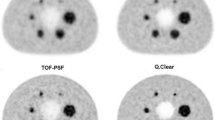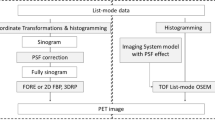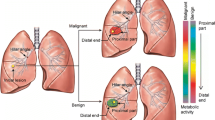Abstract
Objective
We evaluate a fully data-driven method for the combined recovery and motion blur correction of small solitary pulmonary nodules (SPNs) in F-18 fluorodeoxyglucose (FDG) positron emission tomography (PET)/computed tomography (CT).
Methods
The SPN was segmented in the low-dose CT using a variable Hounsfield threshold and morphological constraints. The combined effect of limited spatial resolution and motion blur in the SPN’s PET image was then modelled by an effective Gaussian point-spread function (psf). Both isotropic and non-isotropic psfs were used. To validate the method, PET/CT measurements of the NEMA/IEC spheres phantom were performed. The method was applied to 50 unselected SPNs ≤30 mm from routine patient care.
Results
Recovery of standardised uptake value (SUV) in the phantom image was significantly improved by combined recovery and motion blur correction compared with recovery-only correction, particularly with the non-isotropic model (residual average error 10%). In the patient images, automated segmentation and fit of the effective psf worked properly in all cases. Volume-equivalent diameter ranged from 4.9 to 27.8 mm. Uncorrected maximum SUV ranged from 0.9 to 13.3. Compared with recovery-only correction, combined correction with the non-isotropic model resulted in a ‘relevant’ (≥30%) SUV increase in 47 SPNs (94%).
Conclusions
Correction of both recovery and motion blur is mandatory for accurate SUV quantification of SPNs.








Similar content being viewed by others
References
Alberts WM (2007) Diagnosis and management of lung cancer executive summary: ACCP evidence-based clinical practice guidelines, 2nd edn. Chest 132:1S–19S
Mayor S (2005) NICE issues guidance for diagnosis and treatment of lung cancer. BMJ 330:439
National Collaborating Centre for Acute Care at The Royal College of Surgeons of England (2005) The diagnosis and treatment of lung cancer: methods, evidence and guidance. National Institute for Clinical Excellence, London
Kessler RM, Ellis JR Jr, Eden M (1984) Analysis of emission tomographic scan data: limitations imposed by resolution and background. J Comput Assist Tomogr 8:514–522
Soret M, Bacharach SL, Buvat I (2007) Partial-volume effect in PET tumor imaging. J Nucl Med 48:932–945
Hickeson M, Yun M, Matthies A, Zhuang H, Adam LE, Lacorte L, Alavi A (2002) Use of a corrected standardized uptake value based on the lesion size on CT permits accurate characterization of lung nodules on FDG-PET. Eur J Nucl Med Mol Imaging 29:1639–1647
Avril N, Dose J, Janicke F, Bense S, Ziegler S, Laubenbacher C, Romer W, Pache H, Herz M, Allgayer B, Nathrath W, Graeff H, Schwaiger M (1996) Metabolic characterization of breast tumors with positron emission tomography using F-18 fluorodeoxyglucose. J Clin Oncol 14:1848–1857
Avril N, Bense S, Ziegler SI, Dose J, Weber W, Laubenbacher C, Romer W, Janicke F, Schwaiger M (1997) Breast imaging with fluorine-18-FDG PET: quantitative image analysis. J Nucl Med 38:1186–1191
Goerres GW, Kamel E, Seifert B, Burger C, Buck A, Hany TF, Von Schulthess GK (2002) Accuracy of image coregistration of pulmonary lesions in patients with non-small cell lung cancer using an integrated PET/CT system. J Nucl Med 43:1469–1475
Erdi YE, Nehmeh SA, Pan T, Pevsner A, Rosenzweig KE, Mageras G, Yorke ED, Schoder H, Hsiao W, Squire OD, Vernon P, Ashman JB, Mostafavi H, Larson SM, Humm JL (2004) The CT motion quantitation of lung lesions and its impact on PET-measured SUVs. J Nucl Med 45:1287–1292
Mageras GS, Pevsner A, Yorke ED, Rosenzweig KE, Ford EC, Hertanto A, Larson SM, Lovelock DM, Erdi YE, Nehmeh SA, Humm JL, Ling CC (2004) Measurement of lung tumor motion using respiration-correlated CT. Int J Radiat Oncol Biol Phys 60:933–941
Kawano T, Ohtake E, Inoue T (2008) Deep-inspiration breath-hold PET/CT of lung cancer: maximum standardized uptake value analysis of 108 patients. J Nucl Med 49:1223–1231
de Geus-Oei LF, van Krieken JH, Aliredjo RP, Krabbe PF, Frielink C, Verhagen AF, Boerman OC, Oyen WJ (2007) Biological correlates of FDG uptake in non-small cell lung cancer. Lung Cancer 55:79–87
Lowe VJ, Fletcher JW, Gobar L, Lawson M, Kirchner P, Valk P, Karis J, Hubner K, Delbeke D, Heiberg EV, Patz EF, Coleman RE (1998) Prospective investigation of positron emission tomography in lung nodules. J Clin Oncol 16:1075–1084
Meirelles GS, Erdi YE, Nehmeh SA, Squire OD, Larson SM, Humm JL, Schoder H (2007) Deep-inspiration breath-hold PET/CT: clinical findings with a new technique for detection and characterization of thoracic lesions. J Nucl Med 48:712–719
Nehmeh SA, Erdi YE, Meirelles GS, Squire O, Larson SM, Humm JL, Schoder H (2007) Deep-inspiration breath-hold PET/CT of the thorax. J Nucl Med 48:22–26
Dawood M, Buther F, Jiang X, Schafers KP (2008) Respiratory motion correction in 3-D PET data with advanced optical flow algorithms. IEEE Trans Med Imaging 27:1164–1175
Park SJ, Ionascu D, Killoran J, Mamede M, Gerbaudo VH, Chin L, Berbeco R (2008) Evaluation of the combined effects of target size, respiratory motion and background activity on 3D and 4D PET/CT images. Phys Med Biol 53:3661–3679
Nehmeh SA, Erdi YE (2008) Respiratory motion in positron emission tomography/computed tomography: a review. Semin Nucl Med 38:167–176
Wiemker R, Paulus T, Kabus S, Bülow T, Apostolova I, Buchert R, Klutmann S (2008) Combined motion blur and partial volume correction for computer aided diagnosis of pulmonary nodules in PET/CT. Int J CARS 3:105–113
Nahmias C, Wahl LM (2008) Reproducibility of standardized uptake value measurements determined by 18F-FDG PET in malignant tumors. J Nucl Med 49:1804–1808
International Electrotechnical Commission (1998) International Standard: radionuclide imaging devices—characteristics and test conditions. Part 1: Positron emission tomographs. International Electrotechnical Commission (IEC), Geneva
National Electrical Manufacturers Association (2001) Performance measurements of scintillation cameras. National Electrical Manufacturers Association (NEMA), Washington D.C.
Egger M (2005) Design considerations for PET/CT tomographs. Nuklearmedizin 44(Suppl 1):S63–S64
Hu Z, Wang W, Gualtieri EE, Hsieh YL, Karp JS, Matej S, Parma MJ, Tung CH, Walsh ES, Werner M, Gagnon D (2007) An LOR-based fully-3D PET image reconstruction using a blob-basis function. IEEE Nuclear Science Symposium Conference Record 6:4415–4418
Beyer T, Antoch G, Blodgett T, Freudenberg LF, Akhurst T, Mueller S (2003) Dual-modality PET/CT imaging: the effect of respiratory motion on combined image quality in clinical oncology. Eur J Nucl Med Mol Imaging 30:588–596
Kim SC, Machac J, Krynyckyi BR, Knesaurek K, Krellenstein D, Schultz B, Gribetz A, DePalo L, Teirstein A, Kim CK (2008) Fluoro-deoxy-glucose positron emission tomography for evaluation of indeterminate lung nodules: assigning a probability of malignancy may be preferable to binary readings. Ann Nucl Med 22:165–170
Nie Y, Li Q, Li F, Pu Y, Appelbaum D, Doi K (2006) Integrating PET and CT information to improve diagnostic accuracy for lung nodules: a semiautomatic computer-aided method. J Nucl Med 47:1075–1080
Author information
Authors and Affiliations
Corresponding author
Additional information
I. Apostolova and R. Wiemker contributed equally to this study
Rights and permissions
About this article
Cite this article
Apostolova, I., Wiemker, R., Paulus, T. et al. Combined correction of recovery effect and motion blur for SUV quantification of solitary pulmonary nodules in FDG PET/CT. Eur Radiol 20, 1868–1877 (2010). https://doi.org/10.1007/s00330-010-1747-1
Received:
Revised:
Accepted:
Published:
Issue Date:
DOI: https://doi.org/10.1007/s00330-010-1747-1




